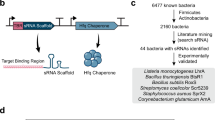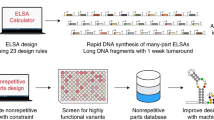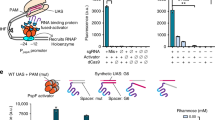Abstract
Small regulatory RNAs (sRNAs) regulate gene expression in bacteria. We designed synthetic sRNAs to identify and modulate the expression of target genes for metabolic engineering in Escherichia coli. Using synthetic sRNAs for the combinatorial knockdown of four candidate genes in 14 different strains, we isolated an engineered E. coli strain (tyrR- and csrA-repressed S17-1) capable of producing 2 g per liter of tyrosine. Using a library of 130 synthetic sRNAs, we also identified chromosomal gene targets that enabled substantial increases in cadaverine production. Repression of murE led to a 55% increase in cadaverine production compared to the reported engineered strain (XQ56 harboring the plasmid p15CadA)1. The design principles and the engineering strategy using synthetic sRNAs reported here are generalizable to other bacteria and applicable in developing superior producer strains. The ability to fine-tune target genes with designed sRNAs provides substantial advantages over gene-knockout strategies and other large-scale target identification strategies owing to its easy implementation, ability to modulate chromosomal gene expression without modifying those genes and because it does not require construction of strain libraries.
This is a preview of subscription content, access via your institution
Access options
Subscribe to this journal
Receive 12 print issues and online access
$209.00 per year
only $17.42 per issue
Buy this article
- Purchase on Springer Link
- Instant access to full article PDF
Prices may be subject to local taxes which are calculated during checkout



Similar content being viewed by others
References
Qian, Z.-G., Xia, X.-X. & Lee, S.Y. Metabolic engineering of Escherichia coli for the production of cadaverine: a five-carbon diamine. Biotechnol. Bioeng. 108, 93–103 (2011).
Pfleger, B.F., Pitera, D.J., Smolke, C.D. & Keasling, J.D. Combinatorial engineering of intergenic regions in operons tunes expression of multiple genes. Nat. Biotechnol. 24, 1027–1032 (2006).
Wang, H.H. et al. Programming cells by multiplex genome engineering and accelerated evolution. Nature 460, 894–898 (2009).
Sharon, E. et al. Inferring gene regulatory logic from high-throughput measurements of thousands of systematically designed promoters. Nat. Biotechnol. 30, 521–530 (2012).
Sandoval, N.R. et al. Strategy for directing combinatorial genome engineering in Escherichia coli. Proc. Natl. Acad. Sci. USA 109, 10540–10545 (2012).
Ho, C.H. et al. A molecular barcoded yeast ORF library enables mode-of-action analysis of bioactive compounds. Nat. Biotechnol. 27, 369–377 (2009).
Kress, W.J. & Erickson, D.L. DNA barcodes: genes, genomics, and bioinformatics. Proc. Natl. Acad. Sci. USA 105, 2761–2762 (2008).
Saito, H. & Inoue, T. Synthetic biology with RNA motifs. Int. J. Biochem. Cell Biol. 41, 398–404 (2009).
Desai, S.K. & Gallivan, J.P. Genetic screens and selections for small molecules based on a synthetic riboswitch that activates protein translation. J. Am. Chem. Soc. 126, 13247–13254 (2004).
Isaacs, F.J. et al. Engineered riboregulators enable post-transcriptional control of gene expression. Nat. Biotechnol. 22, 841–847 (2004).
Carothers, J.M., Goler, J.A., Juminaga, D. & Keasling, J.D. Model-driven engineering of RNA devices to quantitatively program gene expression. Science 334, 1716–1719 (2011).
Sharma, V., Yamamura, A. & Yokobayashi, Y. Engineering artificial small RNAs for conditional gene silencing in Escherichia coli. ACS Synth. Biol. 1, 6–13 (2012).
Liang, J.C., Bloom, R.J. & Smolke, C.D. Engineering biological systems with synthetic RNA molecules. Mol. Cell 43, 915–926 (2011).
Win, M.N. & Smolke, C.D. Higher-order cellular information processing with synthetic RNA devices. Science 322, 456–460 (2008).
Lucks, J.B., Qi, L., Mutalik, V.K., Wang, D. & Arkin, A.P. Versatile RNA-sensing transcriptional regulators for engineering genetic networks. Proc. Natl. Acad. Sci. USA 108, 8617–8622 (2011).
Delebecque, C.J., Lindner, A.B., Silver, P.A. & Aldaye, F.A. Organization of intracellular reactions with rationally designed RNA assemblies. Science 333, 470–474 (2011).
Kang, Z., Wang, X., Li, Y., Wang, Q. & Qi, Q. Small RNA RyhB as a potential tool used for metabolic engineering in Escherichia coli. Biotechnol. Lett. 34, 527–531 (2012).
Gottesman, S. The small RNA regulators of Escherichia coli: Roles and mechanisms. Annu. Rev. Microbiol. 58, 303–328 (2004).
Man, S. et al. Artificial trans-encoded small non-coding RNAs specifically silence the selected gene expression in bacteria. Nucleic Acids Res. 39, e50 (2011).
Urban, J.H. & Vogel, J. Translational control and target recognition by Escherichia coli small RNAs in vivo. Nucleic Acids Res. 35, 1018–1037 (2007).
Aiba, H. Mechanism of RNA silencing by Hfq-binding small RNAs. Curr. Opin. Microbiol. 10, 134–139 (2007).
Pichon, C., du Merle, L., Caliot, M.E., Trieu-Cuot, P. & Le Bouguénec, C. An in silico model for identification of small RNAs in whole bacterial genomes: characterization of antisense RNAs in pathogenic Escherichia coli and Streptococcus agalactiae strains. Nucleic Acids Res. 40, 2846–2861 (2012).
Culver, G.M. Meanderings of the mRNA through the ribosome. Structure 9, 751–758 (2001).
Na, D., Lee, S. & Lee, D. Mathematical modeling of translation initiation for the estimation of its efficiency to computationally design mRNA sequences with a desired expression level in prokaryotes. BMC Syst. Biol. 4, 71 (2010).
Lütke-Eversloh, T. & Stephanopoulos, G. L-tyrosine production by deregulated strains of Escherichia coli. Appl. Microbiol. Biotechnol. 75, 103–110 (2007).
Juminaga, D. et al. Modular engineering of L-tyrosine production in Escherichia coli. Appl. Environ. Microbiol. 78, 89–98 (2012).
Lee, S.Y., Lee, K.M., Chan, H.N. & Steinbüchel, A. Comparison of recombinant Escherichia coli strains for synthesis and accumulation of poly-(3-hydroxybutyric acid) and morphological changes. Biotechnol. Bioeng. 44, 1337–1347 (1994).
Lütke-Eversloh, T. & Stephanopoulos, G. Combinatorial pathway analysis for improved L-tyrosine production in Escherichia coli: identification of enzymatic bottlenecks by systematic gene overexpression. Metab. Eng. 10, 69–77 (2008).
Hua, Q., Yang, C., Baba, T., Mori, H. & Shimizu, K. Responses of the central metabolism in Escherichia coli to phosphoglucose isomerase and glucose-6-phosphate dehydrogenase knockouts. J. Bacteriol. 185, 7053–7067 (2003).
Kadir, T.A., Mannan, A., Kierzek, A., McFadden, J. & Shimizu, K. Modeling and simulation of the main metabolism in Escherichia coli and its several single-gene knockout mutants with experimental verification. Microb. Cell Fact. 9, 88 (2010).
Markham, N.R. & Zuker, M. UNAFold: software for nucleic acid folding and hybridization. Methods Mol. Biol. 453, 3–31 (2008).
Jana, N.K., Roy, S., Bhattacharyya, B. & Mandal, N.C. Amino acid changes in the repressor of bacteriophage λ due to temperature-sensitive mutations in its cI gene and the structure of a highly temperature-sensitive mutant repressor. Protein Eng. 12, 225–233 (1999).
Xia, X.-X. Native-sized recombinant spider silk protein produced in metabolically engineered Escherichia coli results in a strong fiber. Proc. Natl. Acad. Sci. USA 107, 14059–14063 (2010).
Pasquali, C. et al. Two-dimensional gel electrophoresis of Escherichia coli homogenates: the Escherichia coli SWISS-2DPAGE database. Electrophoresis 17, 547–555 (1996).
Acknowledgements
We would like to thank M.-H. Lee for measuring tyrosine and cadaverine concentrations using high-performance liquid chromatography, Y.H. Lee for 2D-PAGE experiments, J.A. Im for large-scale cloning of synthetic sRNAs and cultivation experiments, and S.J. Choi for fermentation experiments. This work was supported by the Technology Development Program to Solve Climate Changes on Systems Metabolic Engineering for Biorefineries (NRF-2012-C1AAA001-2012M1A2A2026556); the Intelligent Synthetic Biology Center through the Global Frontier Project (2011-0031963) of the Ministry of Education, Science and Technology (MEST) through the National Research Foundation of Korea; and the World Class University program (R32-2008-000-10142-0) of MEST.
Author information
Authors and Affiliations
Contributions
S.Y.L. and D.N. conceived of the project. D.N. designed the structure of synthetic sRNAs and performed sRNA construction and evaluation and metabolic engineering experiments. S.M.Y. performed sRNA construction and evaluation and metabolic engineering experiments. H.C. and H.P. carried out large-scale screening for cadaverine production. J.H.P. constructed the S17-1 knockout strain and performed fermentation experiments. S.Y.L. supervised the project. All authors contributed to the preparation of the manuscript.
Corresponding author
Ethics declarations
Competing interests
The authors declare no competing financial interests.
Supplementary information
Supplementary Text and Figures
Supplementary Figures 1–19, Supplementary Tables 1–3 and Supplementary Sequences (PDF 4437 kb)
Rights and permissions
About this article
Cite this article
Na, D., Yoo, S., Chung, H. et al. Metabolic engineering of Escherichia coli using synthetic small regulatory RNAs. Nat Biotechnol 31, 170–174 (2013). https://doi.org/10.1038/nbt.2461
Received:
Accepted:
Published:
Issue Date:
DOI: https://doi.org/10.1038/nbt.2461
This article is cited by
-
Mapping competitive pathways to terpenoid biosynthesis in Synechocystis sp. PCC 6803 using an antisense RNA synthetic tool
Microbial Cell Factories (2023)
-
A novel strategy for l-arginine production in engineered Escherichia coli
Microbial Cell Factories (2023)
-
CRISPR–dCas12a-mediated genetic circuit cascades for multiplexed pathway optimization
Nature Chemical Biology (2023)
-
Targeted and high-throughput gene knockdown in diverse bacteria using synthetic sRNAs
Nature Communications (2023)
-
Dynamic feedback regulation for efficient membrane protein production using a small RNA-based genetic circuit in Escherichia coli
Microbial Cell Factories (2022)



